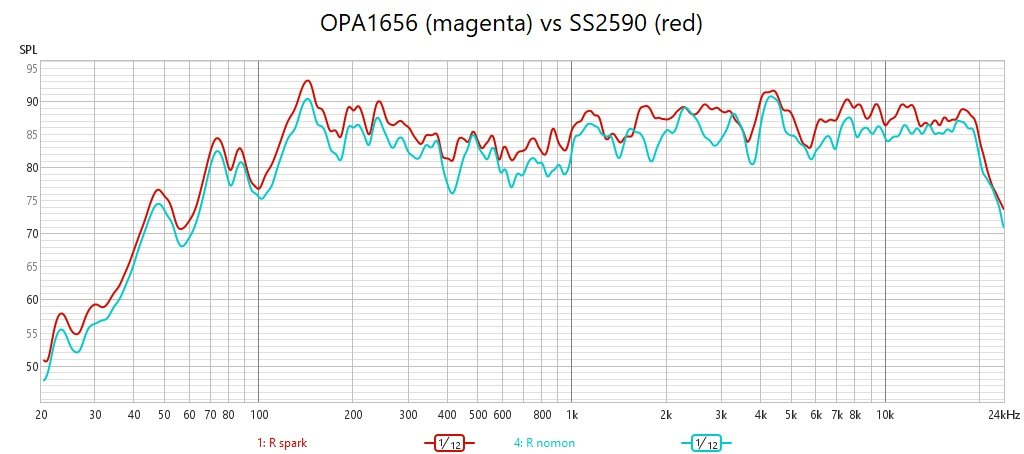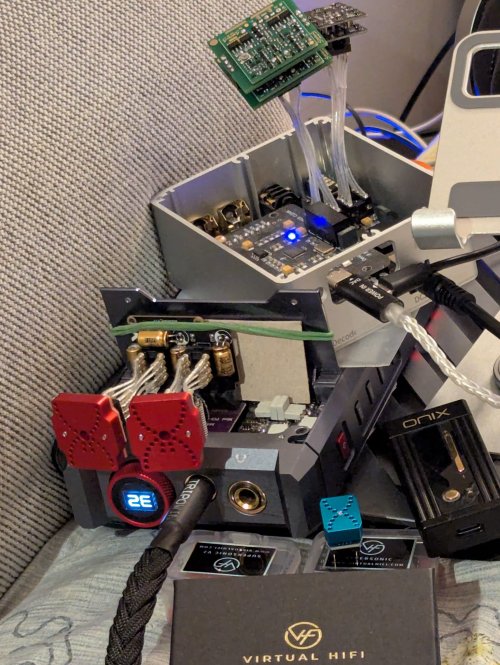Ah, sorry, I believe power is arranged quite differently on this one compared to those DAPs and amps I had practical experience with.
Feel free to PM me photos of the main PCB under the amp PCB daughter board, we can try brainstorming it (to not to take this thread off-topic).
Or ask in the dedicated thread, I believe there’s one here and the may be some people with specific practical knowledge there too.
Will think about it as much as I know about Aune T1 thread - I think I`m actually first one to change its HO opamp and try out different ones (quinea pig)!
Finally had time to solder ADA4084-2ARZ in DIP-8 to SOIC-8 converter PCB and installed it into my modded Aune T1.
Initial impressions after 10min listening - detailed, open and airy sounding (at times "holographic" but at same time with smidge of fowardness in vocals & instruments), well balanced sound, extended but not harsh/sibilant highs (cymbals and crashes sound very detailed and clear).
This is very good opamp and it might top even OPA1612A in this setup/gear but I`m suspecting OPA2228PA still sounds more organic and natural with great details all over spectrum, very open soundstage and tight textured bass.
Will report back after some "burn-in".
Current subjective preference in order (might change):
1) OPA2228PA
2) ADA4084-2ARZ / OPA1612AID (need to compare more)
3) NE5532A / NE5532PA
4) AD8599 (too bright/sibilant in this gear, otherwise detail-monster)
Edit: Did swap as fast as I could and OPA2228PA is just another level compared to ADA4084-2ARZ (at least in this hardware setup).
What I noticed was also slight upper-mid-bass/lower-mids "boom" with 4084 but know that I`m sensitive to any kind of mid-bass boost and prefer "dead-flat" mid-bass with rather slightly raised sub-bass and low extension (not bass-head). I mainly listen prog-rock-metal-jazz.
OPA2228 bass also hits harder and tighter and soundstage is "holographic" and very open/airy with more natural decays/reverbs.
Anyway, 4084 back to "oven" and lets hear if it changes better...
Edit: Hmmm... seems 4084-2 is humming very slightly when no music playing. Idk if it is occillating or I damaged it during soldering or just mismatch with this hardware but I better take it out for now and stay with OPA2228PA.
Edit2: LOL, I totally forgot about EMI/electronics nearby! Since my Aune T1 had open shell and my PC (sound source) was currently laying nearby "naked" without shell too, I was holding T1 too close to it and that`s where from that slight "hum" came. So, 4084-2 back to "burn-in".
Btw, did more listening and opamp lineup has changed for Aune T1:
1) OPA2228PA - most natural, organic, open, airy, balanced (think of Harman target), large soundstage & "holographic", layered, best imaging, sounding out of those.
It is just so coherent and revealing without being "hollow" or "details in Your face" (like AD8599).
2) OPA1612AID - well balanced but doesn`t sound so organic/natural and "misses something" that OPA2228PA has. Nothing bad, nothing really great - which makes it kind of "boring sounding". It just doesn`t grasp You into music like OPA2228PA.
3) NE5532A / NE5532PA - open/airy soundstage and pretty great imaging/layering but misses some mids timbre and bass/percussion tightness/thump (which sound laid-back sometimes). Very good opamp actually but some details/instruments may sound slightly "out of balanced/subdued".
4) AD8599 - this is detail-monster like I said previously. Soundstage is very open/airy and bass/percussion is tight/punchy (beating 5322 & 1612) but highs can sound somewhat sibilant/harsh & "strident" depending on record/genre. I imagine if I had HPs with less highs/details and warm source - this opamp could do wonders.
5) ADA4084-2ARZ - first thing I notice with this opamp is slightly boosted mid-bass / low-mids "glare", which ruins overall "picture". I imagine this opamp would suit source gear with recessed mid-bass/low-mids as otherwise it sounds pretty good in other areas. In my rig - no go.
X) Burson V5i-D - did not work
 It has separate +-15V power brick and uses no USB-power.
It has separate +-15V power brick and uses no USB-power.





















